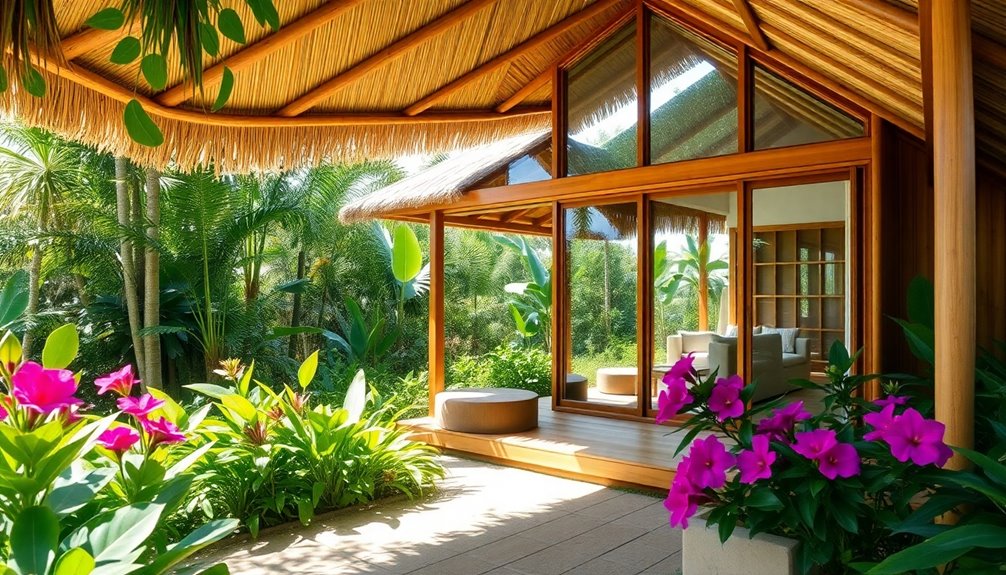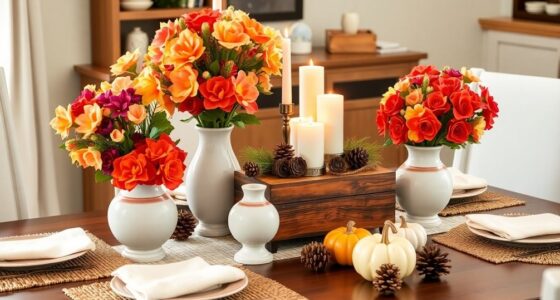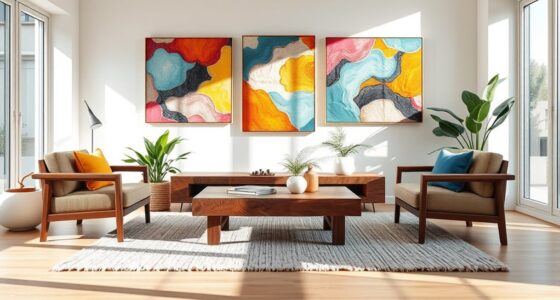The modern bahay kubo transforms the classic Filipino icon by fusing traditional aesthetics with contemporary design. You'll find eco-friendly materials like bamboo and reclaimed wood, along with features such as larger windows for improved airflow. Innovations like solar panels and rainwater systems enhance sustainability. These homes promote open layouts, making them perfect for family gatherings and community ties. With a focus on disaster resistance and urban adaptability, the modern bahay kubo appeals to younger generations seeking simplicity. Discover how this evolution continues to embrace Filipino culture and creativity, offering a new perspective on an enduring symbol.
Key Takeaways
- The modern bahay kubo incorporates contemporary materials like concrete and steel for enhanced durability while retaining traditional aesthetics.
- Eco-friendly technologies, such as solar panels and rainwater systems, are integrated for sustainable living in modern designs.
- Larger windows and adjustable shading systems improve airflow and cooling, adapting to tropical climates efficiently.
- Open layouts and modular construction techniques promote multi-functional urban living spaces, appealing to younger generations.
- Regional variations showcase local craftsmanship, blending traditional elements with modern innovations to preserve cultural heritage while prioritizing sustainability.
Historical Significance of Bahay Kubo
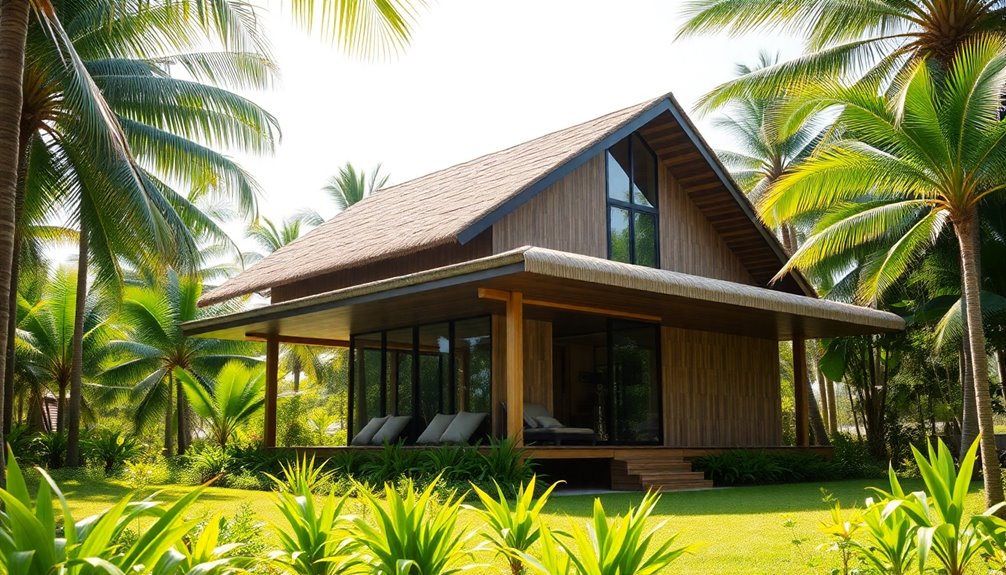
The bahay kubo isn't just a simple nipa hut; it carries deep historical significance in Filipino culture. This traditional Filipino structure evolved from indigenous homes into a symbol of agricultural life and communal values.
Built from locally sourced materials like bamboo and nipa palm, the bahay kubo showcases the adaptability of Filipino architecture to the tropical climate. Its design promotes ventilation and natural cooling, reflecting historical sustainable living practices.
The bahay kubo gained cultural significance during the Spanish colonial era, blending indigenous and colonial styles. Today, it stands as a representation of Filipino identity, inspiring artistic expressions and remaining an important cultural symbol in festivals, literature, and community gatherings.
Embracing this heritage enriches your understanding of Filipino culture.
Architectural Features and Innovations
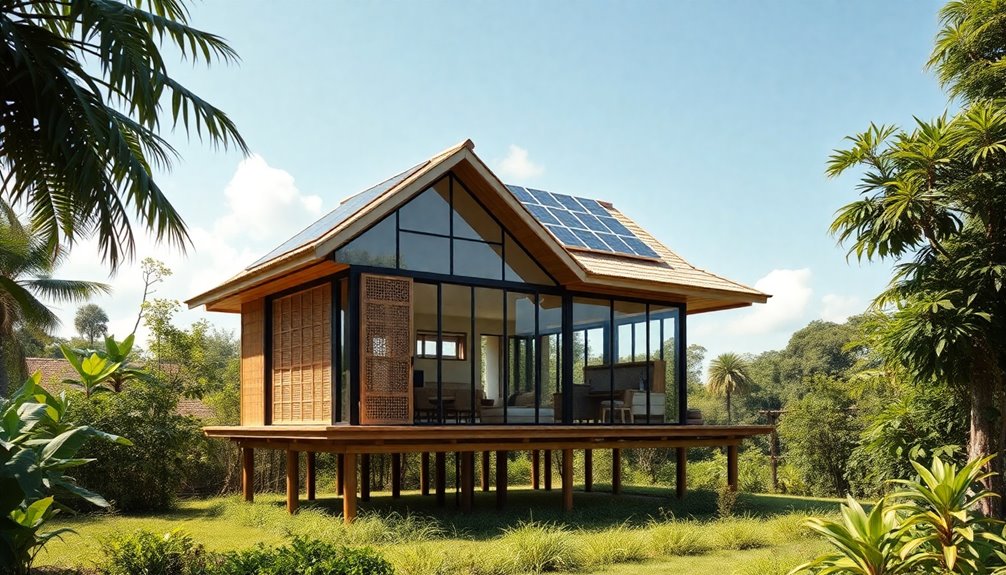
Modern bahay kubo designs seamlessly blend traditional aesthetics with innovative features, creating unique living spaces that honor Filipino heritage while embracing contemporary needs.
These architectural features promote sustainable living through eco-friendly materials and technologies, like solar panels and recycled resources. You'll notice reinforced structures that enhance durability against natural disasters, all while maintaining the classic look.
Larger windows and adjustable shading devices improve airflow and natural cooling, perfect for the tropical climate. Plus, modern bahay kubo often employs modular construction techniques for easy assembly and adaptability in urban settings.
With the integration of smart home technology, you can enjoy automated lighting and climate control, all while appreciating the traditional open-plan layout that defines this iconic Filipino home.
Materials for Sustainable Construction

When you're building a modern bahay kubo, choosing eco-friendly materials is key to sustainability.
You can source local materials, which not only supports your community but also reduces transportation emissions.
Plus, innovative construction techniques can help streamline the process while maximizing efficiency and minimizing waste.
Eco-Friendly Building Materials
While constructing a modern bahay kubo, choosing eco-friendly building materials is crucial for sustainability.
By selecting sustainable building materials, you not only minimize your environmental impact but also create a healthier living space.
Here are some materials to take into account:
- Bamboo: A fast-growing, renewable resource.
- Reclaimed wood: Reduces waste and gives character.
- Natural insulation: Straw and recycled paper enhance energy efficiency.
- Low-VOC paints: Guarantee better indoor air quality.
- Green roofs: Promote biodiversity and improve rainwater absorption.
Integrating these eco-friendly options into your design not only embodies the spirit of the traditional bahay kubo but also embraces modern principles of sustainability, making your home a truly responsible choice. Additionally, utilizing efficient wood stoves can further enhance your home's sustainability and lower your carbon footprint.
Local Sourcing Practices
Choosing locally sourced materials is essential for creating a sustainable modern bahay kubo, as it not only minimizes environmental impact but also supports local economies.
By utilizing sustainable bamboo, nipa palm, and hardwoods, you can achieve a design that harmonizes with local conditions while maintaining traditional aesthetics. These materials enhance the durability and resilience of your structure, making it better equipped to withstand natural disasters.
Additionally, local sourcing reduces transportation emissions and fosters community engagement by generating job opportunities in harvesting and processing.
Emphasizing eco-friendly practices like natural ventilation aligns your bahay kubo with green architecture principles, ensuring a comfortable living space that respects both the environment and cultural heritage.
Innovative Construction Techniques
To build a modern bahay kubo that stands the test of time, consider innovative construction techniques that embrace sustainable materials.
These methods not only enhance durability but also promote eco-friendliness.
Here are some key features to include:
- Engineered bamboo for strength and flexibility
- Recycled steel to reduce waste and improve longevity
- Solar panels for energy efficiency
- Rainwater harvesting systems to conserve resources
- Eco-friendly finishes and non-toxic paints to minimize environmental impact.
In addition, integrating rainwater harvesting systems can greatly contribute to sustainable water management practices, similar to the importance of locating water sources in the wilderness.
Cultural Relevance in Modern Society
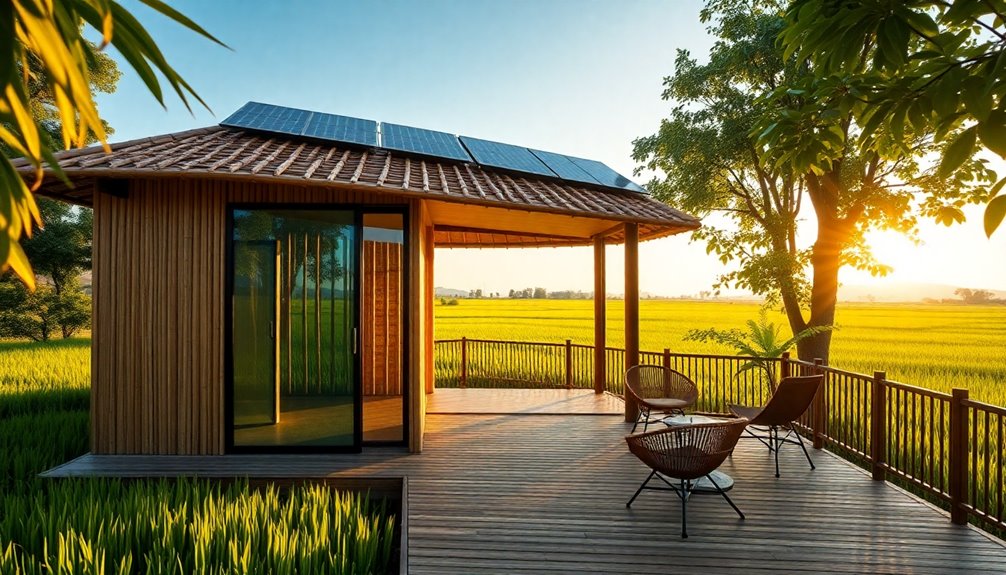
As more people seek sustainable living options, the modern bahay kubo emerges as a powerful cultural symbol in today's society. This adaptation reflects the values of modern Filipinos, emphasizing communal living and strong family ties in shared spaces.
By incorporating eco-friendly materials and technologies, the modern bahay kubo promotes environmental awareness and resilience against climate change. It stands in stark contrast to traditional bahay kubo designs, showcasing how you can honor your roots while embracing contemporary needs.
Many younger generations are drawn to this resurgence, yearning for simpler lifestyles that prioritize sustainability. With a seamless blend of functionality and cultural heritage, the modern bahay kubo represents an invigorating take on what it means to live meaningfully in today's world.
Unique Regional Variations
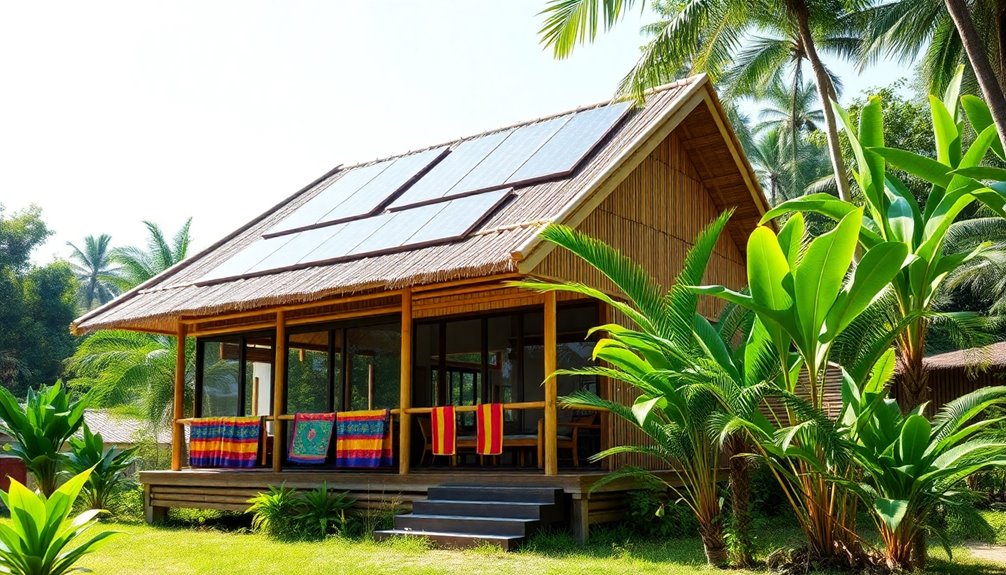
When you explore the unique regional variations of the bahay kubo, you'll notice how craftsmanship differs across the Philippines.
Each area uses specific materials based on local availability and climate, shaping the design and durability of these homes.
These variations not only reflect environmental conditions but also the rich cultural narratives of their respective regions.
Regional Craftsmanship Differences
While exploring the unique regional variations of the bahay kubo, you'll notice how local craftsmanship beautifully reflects cultural influences. Each region showcases distinct styles and techniques that highlight their heritage.
Here are some key aspects you might find:
- Intricate carvings in the Visayas, displaying local artisans' craftsmanship.
- Indigenous motifs prevalent in Mindanao, representing diverse ethnic cultures.
- Durable materials like stone and wood used in Northern Luzon for climatic adaptations.
- Roofing styles that vary from steeply pitched for heavy rainfall to flatter designs suited for drier areas.
- Stilted structures in coastal regions, built to withstand flooding and tailored for fishing communities.
These regional variations not only enhance the bahay kubo's functionality but also celebrate its rich cultural tapestry.
Materials Based on Location
The materials used in constructing a bahay kubo reveal a lot about the local environment and culture. In the Visayas, intricate carvings showcase local artistry, while Mindanao variants often use hardwoods and bamboo, honoring indigenous traditions.
If you visit Northern Luzon, you'll find sturdier versions made from stone and wood, adapting to the cooler climate. Coastal areas feature elevated nipa huts on stilts, crafted with thatch from local palm species, ensuring resilience against floods.
These adaptations highlight the versatility of the Filipino house, using natural materials uniquely suited to each region's distinct environmental contexts. The bahay kubo remains a symbol of the resourcefulness and creativity of Filipino culture, evolving with the landscape while maintaining its iconic charm.
Modern Adaptations and Designs
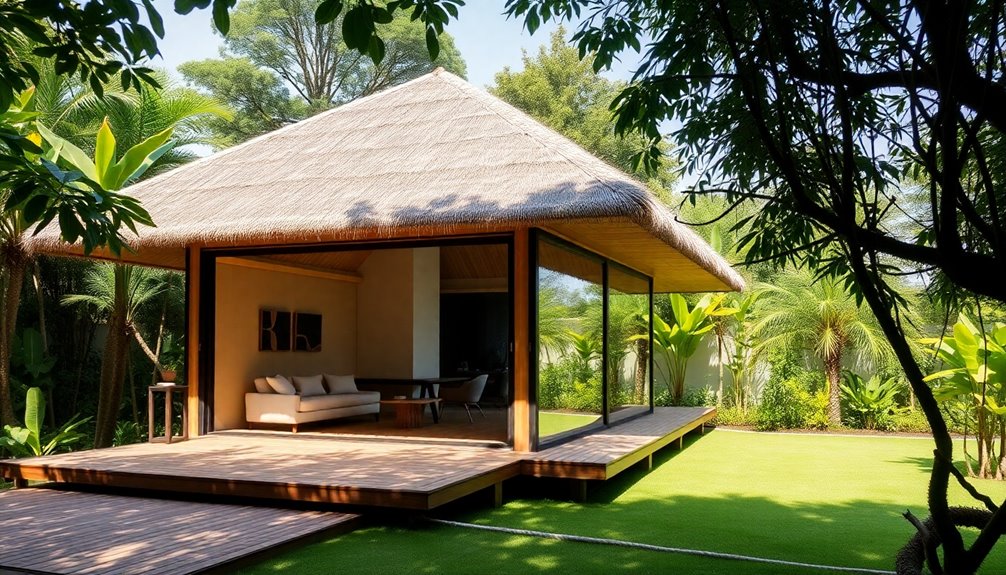
Modern adaptations of bahay kubo blend traditional charm with contemporary needs, creating a unique living experience that appeals to today's homeowners.
These designs often incorporate:
- Reinforced materials like concrete and steel for enhanced durability.
- Eco-friendly technologies such as solar panels and rainwater collection systems.
- Open layouts that promote multi-functional spaces, ideal for urban living.
- Vacation home options that merge traditional craftsmanship with modern amenities.
- Innovative projects like The Strides at LIMA, emphasizing sustainability and local heritage.
These modern adaptations not only respect the cultural significance of the bahay kubo but also meet the practical demands of modern life, making them relevant and desirable in today's fast-paced world.
Community and Social Impact
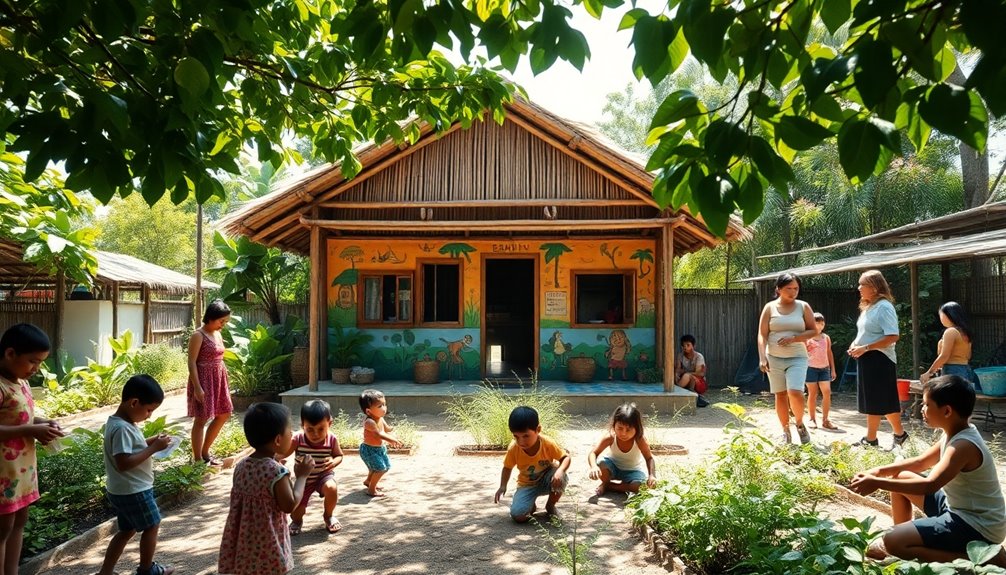
As you explore the community and social impact of modern bahay kubo, you'll find that these structures often act as crucial gathering spaces that strengthen social ties and foster interactions among neighbors.
In both rural and urban settings, these homes promote Filipino living by encouraging communal gatherings and reinforcing family ties. The open layouts and natural ventilation invite families and friends to come together, enhancing community engagement.
These modern adaptations reflect the Filipino spirit of bayanihan, fostering collective support and cooperation. Additionally, the revival of traditional architecture boosts cultural pride, encouraging local artisans to preserve their heritage.
Environmental Benefits of Bahay Kubo

While many homes contribute to environmental challenges, the bahay kubo stands out for its sustainable design and eco-friendly materials. This traditional structure emphasizes sustainability in multiple ways:
- Locally sourced materials like bamboo and nipa reduce carbon footprints.
- Elevated design enhances natural ventilation, cutting down on artificial cooling.
- Open layouts and large windows increase natural light, lowering energy consumption.
- Eco-friendly technologies, such as rainwater harvesting and solar panels, boost sustainability.
- Natural material use supports local economies, creating jobs in sustainable practices.
Future of Bahay Kubo Architecture

Given the increasing focus on sustainability and cultural identity, the future of bahay kubo architecture looks promising.
You'll see modern designs that blend contemporary elements with traditional materials like bamboo and wood, highlighting both Filipino craftsmanship and eco-friendliness. Architects are prioritizing disaster-resistant features and eco-friendly technologies, such as solar panels, to guarantee these homes withstand climate change.
Urban adaptations will cater to modern city living by offering compact, functional spaces while maintaining the open layouts of traditional bahay kubo. This revival aligns with a growing trend towards sustainable living, as homeowners aim to honor their heritage while minimizing environmental impact.
Innovative projects by organizations like BillionBricks showcase how these modern iterations can provide affordable, eco-friendly housing solutions in urban areas.
Frequently Asked Questions
What Is the Meaning of Modern Bahay Kubo?
The modern bahay kubo blends traditional Filipino architecture with contemporary elements, creating a space that's both functional and culturally resonant.
You'll find open floor plans promoting airflow and communal living, while modern amenities like electricity and plumbing enhance comfort.
It often uses sustainable materials and elevated designs for flood protection, making it both practical and eco-friendly.
Ultimately, the modern bahay kubo serves as a bridge between heritage and modern lifestyle, appealing to your sense of nostalgia and practicality.
What Are the Different Types of Bahay Kubo in the Philippines?
You'll find various types of Bahay Kubo across the Philippines, each reflecting unique regional influences.
In the Visayas, the payag stands out, while Mindanao showcases indigenous motifs. Coastal versions often rest on stilts, adapting to flooding, and some even float for fishermen.
Northern Luzon incorporates stone and wood for durability. Urban adaptations blend traditional aesthetics with modern amenities, serving as guesthouses or recreational spaces, emphasizing community and family gatherings.
What Kind of Art Is the Bahay Kubo?
Imagine a quaint house, its vibrant colors dancing in the sunlight, surrounded by lush greenery.
The bahay kubo embodies traditional Filipino art, showcasing intricate wood carvings and capiz shell windows that reflect skilled craftsmanship.
You'll find it celebrated in paintings and folk songs, symbolizing rural life.
Contemporary artists draw inspiration from its design, blending cultural heritage with modern aesthetics, making the bahay kubo a living canvas of Filipino identity and creativity.
What Is the Genre of Bahay Kubo?
The genre of Bahay Kubo is traditional vernacular architecture.
You'll notice it emphasizes local materials and cultural practices, showcasing the Filipino identity.
This architectural style features raised stilt structures and open floor plans, adapting to the tropical climate. These homes often incorporate large windows and expansive balconies to facilitate airflow and natural light, enhancing comfort in the heat. Additionally, some designs blend traditional elements with modern aesthetics, resulting in unique style houses with turrets that provide a charming twist to the overall appearance. The integration of durable materials ensures resilience against the elements, making these structures both beautiful and functional.
As you explore its significance, you'll see how it represents communal living and agriculture, making it an essential part of Philippine heritage.
Its influence continues, inspiring modern interpretations while maintaining its cultural essence.
Conclusion
In embracing the modern bahay kubo, you're not just celebrating an architectural marvel; you're reigniting a cultural flame that warms the Filipino spirit. This fresh take bridges the past and future, proving that tradition can thrive amidst innovation. As you explore these designs, consider how each structure stands as a demonstration of sustainability and community. Isn't it fascinating how a simple house can encapsulate resilience and creativity, shaping lives one bamboo pole at a time?
